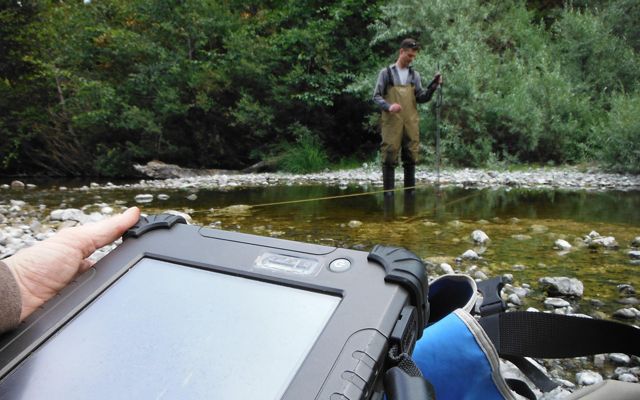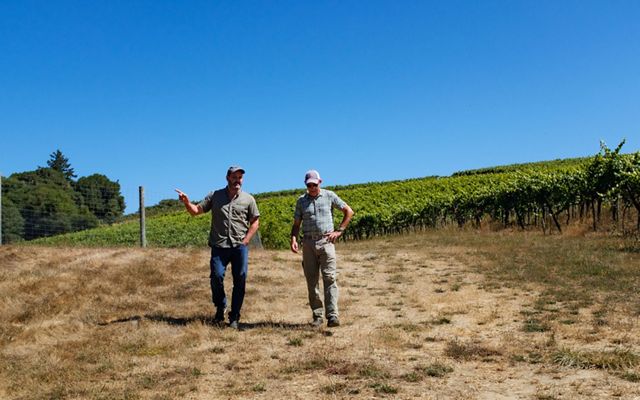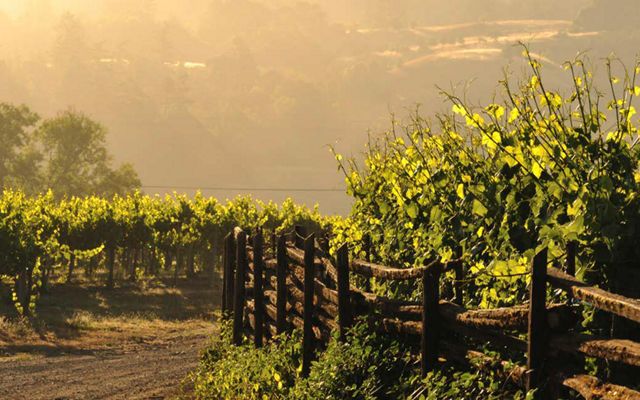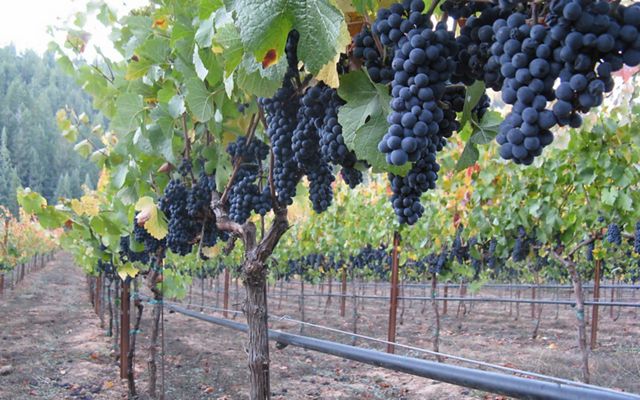Salmon and steelhead are fundamental to the health of the Navarro River watershed, but falling numbers tell a troubling story. Historically, tens of thousands of salmon and steelhead would return from the ocean each year and fight their way back upstream to the Navarro headwaters to spawn. But after a century of water diversions and extensive logging, salmon populations have declined to the point that now only a few hundred fish return each year.
TNC is working to reverse this unacceptable trend by partnering with water users along the Navarro River to develop solutions that preserve water for salmon and people.
Salmon Decline in the Navarro Watershed
In the last 10 years:
- Salmon counts have been below 600 fish per year—8% of their historic numbers.
- Steelhead counts have been below 900 fish—5% of their historic numbers.
Currently, salmon habitat is degraded, and there is too little water in the river, in particular during the summer. The plight of salmon in the Navarro watershed is common in many rivers across the state. In California, nearly half of all salmon and trout are considered endangered and are threatened with extinction because of habitat loss and a lack of water at key times of the year.
A $2.7M Boost for Salmon and Steelhead
Salmon and steelhead recovery efforts in Mendocino County have already seen some big results, with salmon returns at Ten Mile River and Noyo River greatly exceeding recovery targets. Now a $2.75 million grant from the Wildlife Conservation Board (WCB) will support construction of five projects in the Mill Creek sub-basin of the Navarro River Watershed. As part of the Navarro Watershed Streamflow Enhancement 2024 Implementation Project, these five projects will:
- Restore streamflow and enhance habitat for endangered coho salmon and steelhead
- Increase water security for farms and local landowners
- Conserve 63,000 gallons of water annually through innovative storage and groundwater infiltration projects
The $2.75 million grant was submitted by the Mendocino County Resource Conservation District in collaboration with Trout Unlimited and The Nature Conservancy. This WCB funding allows TNC and partners to expand the restoration efforts that have already proven successful in the watershed and elsewhere in the region. TNC and partners' work in the salmon stronghold watersheds of California’s north coast have demonstrated the clear benefits of streamflow enhancement projects, building momentum for this work within the region.
The WCB grant reflects TNC’s strategic approach to conservation. We use science to identify priority places to work, where we know our efforts can have the biggest returns—and that includes inspiring more action. Thanks to private funding from TNC supporters, we’re able to pioneer critical and innovative conservation work on the ground. The benefits proven in these living laboratories enable us to work with our partners and public funders to scale up our efforts—and our impact.
The Power of Partnerships
To make sure there’s enough water in the Navarro River and its connected streams to support salmon and steelhead, TNC is working with many different types of water users, from residential landowners to vineyards, to better manage water diversion in the watershed. Vineyards have been critical partners because of their central place in the local economy and the importance of careful water management in making world renowned wines.
We’re working with Anderson Valley winemakers like Roederer Vineyards, Husch Vineyards and others to measure water levels in Navarro watershed streams throughout the year and create win-win water-use strategies that don’t leave salmon and steelhead behind.
Collaborating with Husch Vineyards
Husch is the oldest vineyard in the Anderson Valley. The 23-acre family-owned operation has been open since the 1970s, and vineyard owner Zac Robinson has been minding the vines since he was a boy. He has also been minding the Navarro River, which runs through the property, by epoxying pennies to rocks along the river to track water level changes over the years. When TNC asked Husch if we could put a stream gage on his property to measure flows there, Zac was thrilled to offer his support.
“We have the same philosophy,” Zac explained. “When [TNC] showed up, they told us two things that piqued our interest: they were driven by science, and collecting these data could help our growing practices as much as it would help nature.”
The gage TNC installed on Zac’s property was one of 16 placed throughout the Navarro River watershed to measure how water diversions were causing summer streamflow levels to dip, a danger for young salmon and steelhead. Guided by this data and to reduce their impacts to the river, Husch installed a new water pump that enabled them to lower their diversion rates from 500 to just 115 gallons per minute, an amount that helps keep the river flowing for fish without sacrificing wine-grape production.
All in the Timing
Reducing irrigation diversion rates is helpful, but it’s only part of the solution. It would be better for Zac—and fish—if Husch could avoid taking water from the Navarro in the summer, when water levels are naturally lowest.
The health of grape vines and the salmon runs of the Navarro River share a common problem—getting the water they need when they need it. Water availability in California is naturally variable, and farms, communities and fish often need water most in the summer when it is least abundant. This challenge is only becoming worse with climate change, as droughts last longer and become more frequent.
Preparing for Summer Water Needs… and Climate Change
Fortunately, the North Coast has a relative abundance of water in the winter and spring. So, TNC is helping Husch and other landowners store water in the rainy season that can then be used during the summer when river levels are lowest and fish desperately need it. Working with Zac, we helped make improvements to a leaky pond that now efficiently stores water for use later in the year and allows Zac to avoid diverting water in the summer. This project is good for fish, but it is also improving Husch’s water security and reliability and is making the vineyard more resilient to the next drought. This project is a powerful demonstration of a concept that can apply to any water user in the Navarro and across California’s coastal watersheds.
The Solution: storing water when it’s abundant for use when it’s scarce.
Mismatched Water Rights
But even a simple solution, like locally storing water in the winter, can butt up against California’s notoriously complex system of water rights and policies. Husch’s existing water right only allows them to pump and store water during the spring and summer rather than in the winter—an artifact of an age gone by that makes very little sense today. Unfortunately, this mismatch is all too common in the Navarro and elsewhere in the state.
Leveraging our work with partners like Husch, TNC is working in the state capital with agencies and legislators to update water policies and laws to enable and encourage smarter water management.
Scaling-Up to Meet a Growing Challenge
A big problem: Salmon and steelhead aren’t just struggling in the Navarro. Their numbers are dwindling all over our state. At the same time, the drought impacts of climate change and increasing human populations are creating growing demand and competition for water.
A big solution: TNC’s California Water Program is focusing our efforts on increasing the pace and scale of our work to restore water flows for nature. Using our scientific expertise, we have identified key watersheds for the restoration and protection of salmon and other wildlife, and we are developing web-based tools that quickly provide information on how much water nature needs in these key streams.
Then, we are bringing community-based water management—like we’ve used in the Navarro—to these key watersheds via the creation of the Environmental Water Network, which will provide technical support and incentivize new partnerships to proliferate these common-sense water solutions across California.
Moving Forward Together
Partnerships with water users like Husch help us devise practical local solutions and then replicate those solutions across California and beyond so that both people and nature throughout the state can thrive. Working together, we can restore the health of freshwater systems that wildlife rely on, while also improving water supply and reliability for people.
This body of work is supported and jointly carried out in collaboration with the Mendocino County Resource Conservation District, as well as with the California Salmon & Steelhead Coalition, a strategic partnership of The Nature Conservancy, Trout Unlimited and California Trout to increase streamflow in California’s North and Central Coast watersheds, with the goal of restoring and protecting wild salmon and steelhead and creating water reliability for people. To learn more, visit: www.casalmonandsteelhead.org.
To learn more about salmon in California, visit the Conservancy’s State of Salmon in California website: www.casalmon.org. This website is the most comprehensive repository of salmon information in California, presenting the current status and historical trends of salmon and steelhead populations and the work of the salmon restoration community.
Make a Difference in California
Together, we can achieve transformative change on a scale that’s attainable—for salmon, for California, and for the world.
















